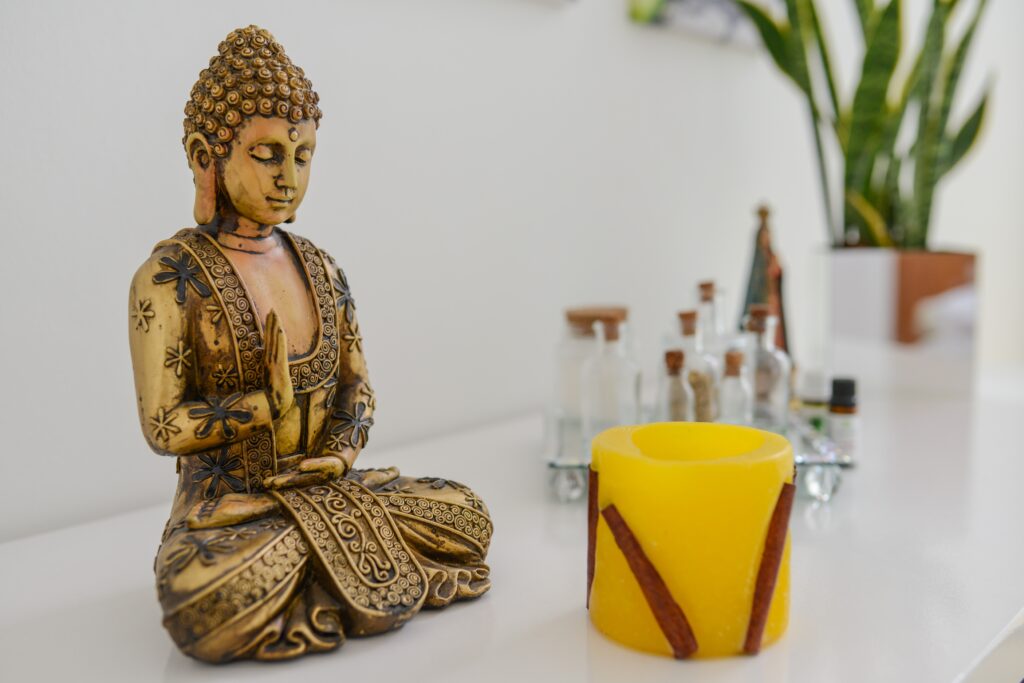Meditation has been around for thousands of years. Its long and varied history spans many different cultures and traditions. In fact, we can trace the origins of meditation back to ancient civilizations in Asia, as well as to ancient spiritual traditions such as Hinduism, Buddhism, and Taoism.
These traditions saw meditation as a way to connect with the divine or to cultivate inner peace and spiritual growth. Some also believed it had physical and mental health benefits, such as improved focus and reduced stress.
Turns out, they were right!
Today, people from many different cultures and walks of life practice it too. While it’s still used for spiritual purposes by some, most of us adopt it to reduce stress in such a fast-paced world (at least, I do).
That being said, there are many different types of meditation practices that have been developed within various spiritual and philosophical traditions around the world. Here are a few examples:

Mindfulness meditation
Mindfulness meditation focuses on the present moment without judgment. This means concentrating on your breath, bodily sensations, or other present-moment experiences, and observing them with an open and curious mind. The goal is to gain a sense of awareness and present-moment presence, and to develop the ability to focus the mind and manage stress and emotions more effectively.
To practice mindfulness meditation, you can find a quiet and comfortable place to focus on your present-moment experience. Feel every breath coming and going out of your body; feel your body laying down, gradually relaxing your muscles. As you focus on your breath or your body, you may find that your mind wanders – and that’s okay. Every time your mind starts wandering, simply bring your attention back to the present moment.
Remember: he goal is not to achieve a state of perfect concentration but rather to relax and give in to the present moment instead of worrying about your future or past experiences all the time. That’s what most beginners in this field want.
Of course, you can practice this type of meditation for a few minutes a day or longer depending on your schedule. The most important thing is consistency!
All in all, many people find that incorporating mindfulness meditation into their daily routine can help them reduce stress, improve focus and concentration, and increase overall well-being.

Loving-kindness meditation
Loving-kindness meditation, also known as metta meditation, means sending feelings of love, compassion, and kindness to those around you (yourself included!). The core idea is that emotions can have a ripple effect, improving your and your loved one’s emotional state.
Luckily, this type of meditation is fairly easy. Start by silently repeating phrases of loving-kindness to yourself, such as:
- “May I be happy. May I be healthy. May I be safe. May I live with ease.”
- “May you be happy. May you be healthy. May you be safe. May you live with ease.”
- “May all beings be happy. May all beings be healthy. May all beings be safe. May all beings live with ease.”
Next, you can expand the focus of your meditation to include loved ones, acquaintances, and ultimately, all beings. As you repeat each word, try to actually visualize the person or group receiving the love and kindness you are sending.
Loving-kindness meditation can be a powerful way to cultivate positive emotions and improve relationships with others. Personally, this exercise has helped in my healing process after I lost a loved one. Simple as they may seem, these phrases reminded me there’s still a lot to hope for – and maybe you’ll feel the same too!
Transcendental meditation
I promise this sounds more complicated than it actually is! Basically, transcendental meditation (TM) is a type of meditation where you use a mantra. A mantra is a phrase (or a single word) you repeat silently in your mind. The first step is to sit comfortably with closed eyes and silently repeating the mantra for 20 minutes, twice per day. Yes, that’s it!
TM is based on the idea that the mind and body are interconnected, and that the natural state of the mind is one of restful alertness. By practicing TM, an individual can tap into this natural state of relaxation. The long-term benefits are reduced stress and anxiety, improved focus, as well as calm and relaxation. Some people also reported experiencing increased creativity and productivity, improved sleep, and improved physical health. However, each experience is unique depending on your mental and emotional states, background, and other factors.
If you feel like this practice is difficult or don’t know where yo start, you can learn the basics of transcendal meditation during personal one-on-one sessions with a trained TM teacher. Actually, I highly recommend opting for professional help with any of the meditation techniques in this article – especially the next one…
Zazen Meditation
Zazen is a form of Zen meditation that originated in Japan. It involves sitting in an upright position, usually on a cushion called a zafu, with the back straight and the legs crossed in a position called the lotus or half-lotus position.
During Zazen meditation, you must focus your attention on your breath, counting each inhalation and exhalation. The goal of zazen is to quiet the mind to improve your overall focus and clarity.
Sometimes, Zazen may also involve walking meditation, where you have to focus on your feet touching the ground as you walk. Chanting, prostrations, and traditional Zen objects such as incense and a bell can also be used (but that’s for pros if you ask me). If you’re a beginner, though, I’d recommend sticking to the basics, such as breathing or walking meditation, at least at first.
Some people find it helpful to set a timer for their meditation sessions, while others prefer to meditate for a set period of time. The length of each session can vary depending on the individual’s preference and the amount of time they have available.

Vipassana Meditation
Vipassana meditation is a type of Buddhist meditation that helps people explore their inner self.
For example, practitioners focus their attention on the present moment and observe their thoughts, feelings, and sensations. This simple practice helps you get a clear view of your life and everything around you.
The best part? You can either practice it while sitting down or while walking – which makes it perfect for anybody regardless of your age or schedule!
Vipassana meditation can be a powerful tool for personal growth and transformation, experts say. Usually, this type of meditation is practiced on special retreats or group sessions.
Chakra Meditation
Chakra meditation involves focusing on the seven chakras. Ancient theories think that chakras are energy centers in your body (which we all presumably have). Each chakra represents a particular aspect of the self like this:
- the base chakra is the foundation of the self;
- the sacral chakra represents emotions and sexuality;
- the crown chakra means spirituality and connection to the divine.
So what’s the core goal of this practice? Put simply, to bring awareness and balance to each of the chakras. This may involve visualizing the chakras and their associated colors, as well as focusing on the qualities and energies associated with each chakra. Some people also use affirmations, mantras, or other techniques to help bring balance to the chakras.
Chakra meditation can be practiced on its own or in combination with other types of meditation.
Kriya Yoga Meditation
Kriya yoga is a spiritual meditation practice within the tradition of yoga. This form of yoga may have originally been taught by the ancient sage Patanjali.
Kriya yoga involves the practice of various techniques, including physical postures (asanas), breath control (pranayama), and meditation, as well as ethical principles and self-discipline. The goal is to cultivate a state of inner stillness, concentration, and awareness, improving your mental state.
In Kriya yoga, the focus is on the breath and the movement of prana (life force energy) through the body. You may use specific techniques to control and direct the breath, such as alternate nostril breathing or retention of the breath, to enter deep meditation.
What makes Kriya yoga different is that it also includes ethical principles and self-discipline. These may include the practice of non-harm, truthfulness, non-stealing, non-possessiveness, and non-attachment, as well as the cultivation of virtues such as compassion, kindness, and self-control.
Sounds complicated? Well, that’s why Kriya yoga is typically taught through a guru-disciple relationship. You can find such specialists in your area, as the practice is fairly popular among meditation practitioners. If it seems too overwhelming, though, I belive starting with basic yoga sessions does the trick too!
Guided Meditation
In guided meditation, there’s an instructor to help you out with each step of your meditation journey. Don’t like to join physical classes? No problem! You can also try this practice individually if you want to, or try a virtual class.
Either way, your guide will give you basic instructions based on your current level. These instructions may include things like breathing exercises, repeating a mantra, and other practices depending on the type of meditation you pick. The guide may also use various techniques such as music to relax or improve your mood! After all, we all need that in our lives, right?
These are just a few examples of meditation practiced around the world. In the end, it’s important to find a type of meditation that resonates with you. If you’ve already tried one or more of my recommendations from above, I’d love to hear about your experience in the comment section!
Discover also: 6 Easy Activities That Work Just as Well as Meditation









